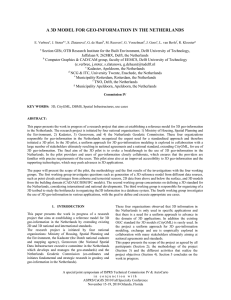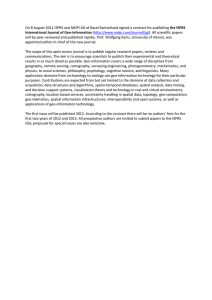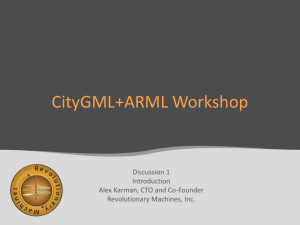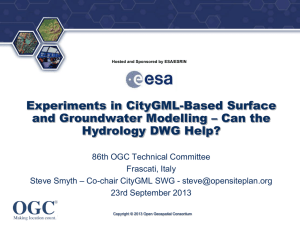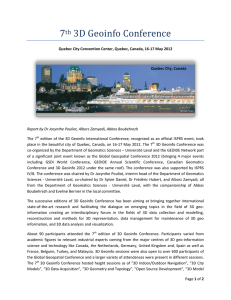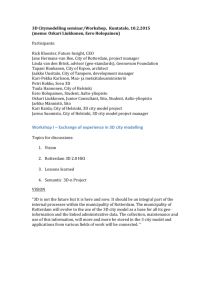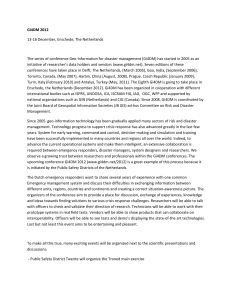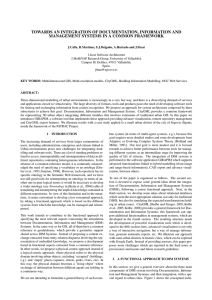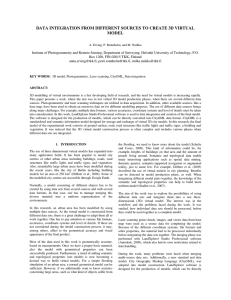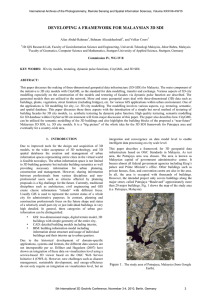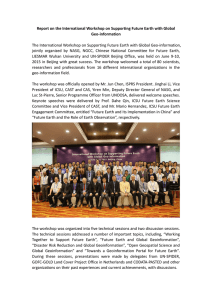TOWARDS A 3D GEO-INFORMATION STANDARD IN THE NETHERLANDS
advertisement
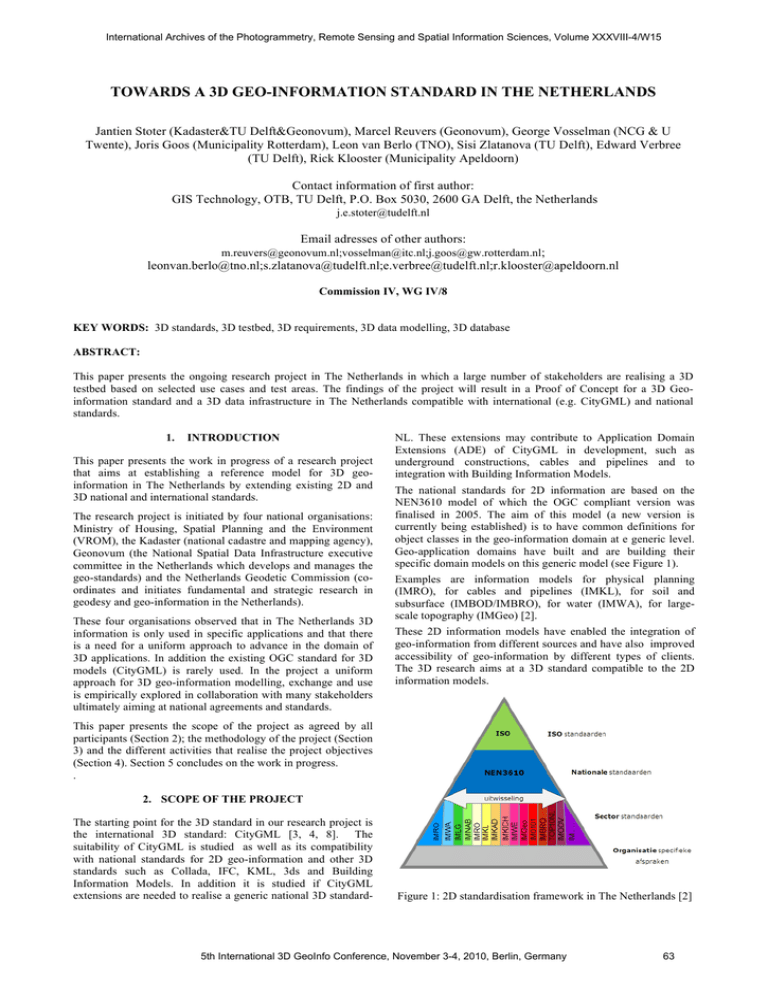
International Archives of the Photogrammetry, Remote Sensing and Spatial Information Sciences, Volume XXXVIII-4/W15 TOWARDS A 3D GEO-INFORMATION STANDARD IN THE NETHERLANDS Jantien Stoter (Kadaster&TU Delft&Geonovum), Marcel Reuvers (Geonovum), George Vosselman (NCG & U Twente), Joris Goos (Municipality Rotterdam), Leon van Berlo (TNO), Sisi Zlatanova (TU Delft), Edward Verbree (TU Delft), Rick Klooster (Municipality Apeldoorn) Contact information of first author: GIS Technology, OTB, TU Delft, P.O. Box 5030, 2600 GA Delft, the Netherlands j.e.stoter@tudelft.nl Email adresses of other authors: m.reuvers@geonovum.nl;vosselman@itc.nl;j.goos@gw.rotterdam.nl; leonvan.berlo@tno.nl;s.zlatanova@tudelft.nl;e.verbree@tudelft.nl;r.klooster@apeldoorn.nl Commission IV, WG IV/8 KEY WORDS: 3D standards, 3D testbed, 3D requirements, 3D data modelling, 3D database ABSTRACT: This paper presents the ongoing research project in The Netherlands in which a large number of stakeholders are realising a 3D testbed based on selected use cases and test areas. The findings of the project will result in a Proof of Concept for a 3D Geoinformation standard and a 3D data infrastructure in The Netherlands compatible with international (e.g. CityGML) and national standards. 1. INTRODUCTION This paper presents the work in progress of a research project that aims at establishing a reference model for 3D geoinformation in The Netherlands by extending existing 2D and 3D national and international standards. The research project is initiated by four national organisations: Ministry of Housing, Spatial Planning and the Environment (VROM), the Kadaster (national cadastre and mapping agency), Geonovum (the National Spatial Data Infrastructure executive committee in the Netherlands which develops and manages the geo-standards) and the Netherlands Geodetic Commission (coordinates and initiates fundamental and strategic research in geodesy and geo-information in the Netherlands). These four organisations observed that in The Netherlands 3D information is only used in specific applications and that there is a need for a uniform approach to advance in the domain of 3D applications. In addition the existing OGC standard for 3D models (CityGML) is rarely used. In the project a uniform approach for 3D geo-information modelling, exchange and use is empirically explored in collaboration with many stakeholders ultimately aiming at national agreements and standards. NL. These extensions may contribute to Application Domain Extensions (ADE) of CityGML in development, such as underground constructions, cables and pipelines and to integration with Building Information Models. The national standards for 2D information are based on the NEN3610 model of which the OGC compliant version was finalised in 2005. The aim of this model (a new version is currently being established) is to have common definitions for object classes in the geo-information domain at e generic level. Geo-application domains have built and are building their specific domain models on this generic model (see Figure 1). Examples are information models for physical planning (IMRO), for cables and pipelines (IMKL), for soil and subsurface (IMBOD/IMBRO), for water (IMWA), for largescale topography (IMGeo) [2]. These 2D information models have enabled the integration of geo-information from different sources and have also improved accessibility of geo-information by different types of clients. The 3D research aims at a 3D standard compatible to the 2D information models. This paper presents the scope of the project as agreed by all participants (Section 2); the methodology of the project (Section 3) and the different activities that realise the project objectives (Section 4). Section 5 concludes on the work in progress. . 2. SCOPE OF THE PROJECT The starting point for the 3D standard in our research project is the international 3D standard: CityGML [3, 4, 8]. The suitability of CityGML is studied as well as its compatibility with national standards for 2D geo-information and other 3D standards such as Collada, IFC, KML, 3ds and Building Information Models. In addition it is studied if CityGML extensions are needed to realise a generic national 3D standard- Figure 1: 2D standardisation framework in The Netherlands [2] 5th International 3D GeoInfo Conference, November 3-4, 2010, Berlin, Germany 63 International Archives of the Photogrammetry, Remote Sensing and Spatial Information Sciences, Volume XXXVIII-4/W15 3. METHODOLOGY To meet the high ambitions of the project, i.e. to establish a national 3D standard, it was clear from the start that (many) suppliers and users of geo-data and geo-information as well as of 3D technologies should be involved. Therefore a call was launched in January 2010. About 90 people from about 50 organisations responded to the call (see Table 1). Most of the motivations that the respondents were asked to write, confirmed the observation that 3D geo-information is currently only used in ad hoc and specific applications. In addition many of the motivations expressed an urgent need for a uniform approach for 3D modelling. A digital working environment has been set up for supporting the collaboration, consisting of a Wiki, a data server and a LinkedIn group. Table 1: Participating organisations in 3D-NL project 4innovations Fugro ITC – U Twente Provincie NB 4sight Kadaster RWS KPG, Polen StrateGIS MERKATOR Bentley Gemeente Apeldoorn Gemeente Amsterdam Gemeente Rotterdam Gemeente Tilburg Geodan TNO Bouw en Ondergrond TNO Defensie en Veligheid TNO ICT LSV GBKN Geodelta Nat. Lucht en Ruimtevaart laboratorium Object Vision Aerodata AGIV AHN BLOM NL Geonovum Cebra Grontmij Crotec Hansa Luftbild Horus surround Vision iDelft Cyclomedia ESRI Eurosense Nedgraphics Neo Figure 2 Schematisation of four activities of the project 4. THE ACTIVITIES TOPOSCOPIE I&C Science, University Utrecht Architect TUD Computer Oosterhuis_Léná Graphics rd Oracle TUD GIST, OTB Oranjewoud TUD Lucht en Ruimtevaart Politie KLPD Alterra Wageningen UR Intergraph This section describes the activities of the project in more detail by listing the main research question(s) and subtasks for every activity. Activity 1 ‘Supply of 3D geo-information’ works on the following research problems: How can 3D information compliant to the 3D reference model be generated from different data sources, such as point clouds and images from airborne and terrestrial sensors, 2D data from above and below the surface, and 3D models from the building domain (CAD/AEC/BIM/IFC)? Five major tasks have been defined: 1.1 1.2 To meet the aims of the project in collaboration with so many organisations and companies four activities have been defined. These activities are executed in coherence with each other and jointly realise the objectives of the project (see Figure 2). The four activities, which will be further detailed in section 4, are: 1.3 1. 1.4 2. 3. 4. Identifying the availability of 3D geo-data and geoinformation and sourcing test data as well as identifying best practices for 3D geo-information acquisition Investigating and defining 3D standard-NL Designing and implementing 3D testbed Specifying needs for 3D geo-information and 3D technologies through use cases and evaluation of prototypes All the participants have subscribed for one of the four activities. This approach provides the possibility that all participants can work on their own expertise and interest while together realising the aims of the 3D project. The four activity-leaders (who co-author this paper) take care of the coherence between the activities. Every two months the progresses of the activities are discussed and aligned in plenary sessions, while every activity has its own intermediate working sessions. 64 1.5 Selecting rural (for less detailed data) and urban (for more dynamic and detailed data) test areas to support varying use cases. Sourcing many different 3D test data sets for the selected test areas: small and large scale, isolated areas and covering larges areas, below and above the surface; detailed and less detailed; terrain and building. Generating 3D information from raw data as well as combining already existing data sets (for example laserscan and topographic data) to generate (new) 3D information. Inventory of available techniques for 3D geo-information generation (conform the standard) and of available techniques to enrich 2D data to 2.5D and 3D information. Making test data available in the 3D standard, also with metadata. If this is not possible, in another accepted standard while shortcomings of CityGML are documented. The main research question for Activity 2 ‘Investigating and defining 3D standard’ are: What will the standard for 3D geoinformation-NL look like? Which concepts (objects and their properties) should be defined and how? How should geometry and topology be defined? What is the link with established 2D information models and with 3D models in other domains? Four major subtasks are defined within this activity: 5th International 3D GeoInfo Conference, November 3-4, 2010, Berlin, Germany International Archives of the Photogrammetry, Remote Sensing and Spatial Information Sciences, Volume XXXVIII-4/W15 2.1 2.2 2.3 2.4 Evaluation of available 3D standards for maintenance, exchange and web visualisation of 3D data such as CityGML, IFC, Collada, KML, indicating the positive and negative characteristics and making this knowledge available within the project via a workshop Motivated selection of a 3D standard for the testbed (most probably CityGML) Definition of required semantic extensions of selected standard based on studying CityGML in relation to 3D models in other domains and in relation to established Dutch 2D information models. Also the experiences in applying CityGML to the different use cases in the 3D testbed will influence the required extensions. Recommendations for changing/extending/innovating CityGML (or other standard) to fit the Dutch needs as a 3D standard. Figure 3: 3D testbed Activity 4 ‘Realising pilots via use cases’ concentrates on the following research question: Which applications ask for what type of 3D information (content, precision, geometry)? Six tasks are defined in this activity: 4.1 The main research questions of Activity 3 ‘3D testbed’ are: How does the physical model for 3D geo-information look like and how can a CityGML file be converted to it? How can 3D geo-information be structured and managed in an integrated manner, as part of generic information flows? How to validate 3D information and data? How to update 3D information? How to interact with 3D geo-information stored in database or CityGML? What is the performance of 3D techniques? The subtasks are: 3.1 3.2 3.3 3.4 3.5 Defining specifications for 3D testbed Design and implementation of environment to store, integrate, manage 3D information including geoweb environment to access the data Importing and dissemination of test data in and from 3D database Supporting data- and technique-suppliers to link to 3D testbed Consolidating the improved and final version of the 3D testbed, while reporting technical issues met in the execution of the testbed. The kernel of the 3D testbed activity is the database. A first version of the database has been implemented by Section GIS technology, Delft University of Technology. This database implements CityGML in Oracle according to http://opportunity.bv.tu-berlin.de/software/projects/3dcitydb. This database will be further developed in the project based on growing insights from applying the data from the database to the use cases. Test data is currently being imported in this database where it is structured and maintained and in a next step disseminated via several ways (see Figure 3). Import and export is done via ETL (Extract Transform Load) tools. The result is that data is stored once while it can be accessed by any user or system multiple times. Defining use cases as collaborations of different stakeholders 4.2 Creating story boards for use cases 4.3 Specify the requirements for the selected use cases 4.4 Running use cases on 3D testbed 4.5 Evaluating results of use case tests 4.6 Studying visualisation and interaction possibilities of 3D data Representative use cases have already been selected within the project. They are all centred around three main applications in the complete cycle of spatial planning and management (from idea, via planning and realisation to maintenance). They are: 3D Data integration: Serious Gaming – 3D input for real time simulation of meteorological processes (Figure 4a). 3D data integration within design and building processes (BIM-IFC-CAD) (Figure 4b). Integration of 3D data above and below the surface for infrastructural planning (Figure 4c). Communication Virtual city for communication with citizens (Figure 4d). 3D spatial planning (Figure 4e). Supplying 3D information 3D Cadastre: from 3D fieldwork to 3D cadastral map (Figure 4f) 3D base set topography for The Netherlands (Figure 4g). This use case studies both the required content and accuracy of such a base dataset, as well as the possibilities to automatically generate the dataset combining existing data sources such as high resolution laserscan data (AHN2, see www.ahn.nl) and 2D large scale topography. Through empirical research (i.e. while doing) all tools are studied which are needed to realise this testbed: the optimal database implementation; CityGML viewers (such as Aristoteles, CityViewer, LandXplorer, FZK Viewer), CityGML converters, Web Services for access as well as tools for 'direct' access independent of the software systems. Specific attention is being paid to validation of CityGML data other than schema checking, since this is currently not available (What is a correct 3D object? Does it touch or overlap with another 3D object?), see [7]. A: 3D input for simulation of meteorological processes, courtesy of Matthijs Danes, Alterra Wageningen UR 5th International 3D GeoInfo Conference, November 3-4, 2010, Berlin, Germany 65 International Archives of the Photogrammetry, Remote Sensing and Spatial Information Sciences, Volume XXXVIII-4/W15 G: 3D Base set Topography NL, courtesy of TUD, iDelft, Eurosense and U Twente). B: 3D data integration in BIMs, courtesy Gijs Joosen, Architect Oosterhuis_Lénárd Figure 4: Use cases of the 3D project-NL 5. WORK IN PROGRESS C: 3D subsurface model, courtesy Jan Kooijman, TNO D: Virtual City, courtesy Rick Klooster, Gemeente Apeldoorn E: Spatial planning in 3D, courtesy Mark Berntssen, 4sight The work on the different activities is running in parallel. One of the test areas where the use cases will be carried out is municipality Rotterdam, which is the owner of many different 3D data sets. 3D test data have been prepared for the test areas. Several of the Dutch 2D standards (Information models) are investigated and compared for the semantic and types of objects that they support to see how they fit in a 3D extension. In addition information models as IFC, BIM and CityGML are studied for possible integration, see also [1, 5, 6]. The pilot is currently entering the execution phase in which the use cases have become the engine of the pilot. Execution of the use cases will be a collaboration of stakeholders of the use case, 3D data and 3D technology providers. The experiences of the use cases will be used to further develop the 3D standard-NL as well as to improve the 3D testbed. The project will finish in spring 2011. Among the end results are: use case descriptions of the selected 3D applications, publicly available test data for two test areas, an operational 3D testbed, demonstrators prototyping the selected use cases, recommendations for 3D geo-information use and 3D technologies as well as for further developing CityGML compatible with 3D standards in other domains and with established 2D information models. These results will be presented during a conference which will be open for everyone. The experiences so far have shown the importance of studying the 3D standard from a dual perspective, i.e. from both the supply and demand perspective. At the one hand the 3D applications should be demand-driven to optimally meet users needs. At the other hand the users can better understand their needs if they know what kind of 3D data and technologies are available. This chicken-egg problem is explicitly addressed in the project. Suppliers and users of geo-information and the supporting technologies work closely together. Suppliers are provided with precise requirements of the users. At the same time growing awareness of available 3D geo-information and the supporting technologies may push the use of 3D information. REFERENCES 1. Emgård, K.L. and S. Zlatanova. 2008. Design of an integrated 3D information model. [red.] Rumor, Fendel and Zlatanova Coors. London, UK : Taylor & Francis Group. Urban and regional data management: UDMS annual 2008. pp. pp. 143-156. 2. Geonovum, 2010, www.geonovum.nl F: 3D Cadastre [9] 66 5th International 3D GeoInfo Conference, November 3-4, 2010, Berlin, Germany International Archives of the Photogrammetry, Remote Sensing and Spatial Information Sciences, Volume XXXVIII-4/W15 3. Gröger G, T. Kolbe, C. Nagel and A. Czerwinski. 2008. Open Geospatial Consortium City Geographic Markup Language. CityGML Encoding Standard document version 1.0.0, adopted international standard. http://www.opengeospatial.org/standards/citygml. [Online] 2008. OGC 08-007r1. 4. Gröger G, T. Kolbe and A. Czerwinski. 2006. OpenGIS CityGML Implementation Specification. http://www.citygml.org/docs/CityGML_Specification_0.3. 0_OGC_06-057.pdf . [Online] 2006. 5. Isikdag, U. and S. Zlatanova. 2009. A SWOT Analysis on the Implementation of Building Information Models within the Geospatial Environment, In: Krek, Rumor, Zlatanova, Fendel (Eds.); Urban and Regional data Management, UDMS Annuals 2009, Taylor & Francis/CRC Press, pp. 15-30 6. Isikdag, U. and S. Zlatanova. 2009b. Towards defining a framework for automatic generation of buildings in CityGML using Building Information Models In: J. Lee and S. Zlatanova (Eds.); 3D Geo-Information Sciences, Springer, 2009, pp. 79-96 7. Ledoux,H., E. Verbree and Hang Si. 2009. Geomatric Validation of GML Solids with the Constrained Delaunay Tetrahedralization, In: De Mayeer, Neutens, De Rijck (Eds.); Proceedings of the 4th International Workshop on 3D Geo-Information, November 2009, Ghent, pp. 143-148 8. OGC. 2009. CityGML specification document version 0.4.0, approved Best Practice Paper. http://www.opengeospatial.org/standards/bp. [Online] 2009. OGC 07-062. 9. Stoter, 2004. 3D Cadastre, PhD Thesis, Technical University of Delft. ACKNOWLEDGEMENTS We are deeply grateful to all 85 participants of this project who actively contribute to the activities and discussions. 5th International 3D GeoInfo Conference, November 3-4, 2010, Berlin, Germany 67
